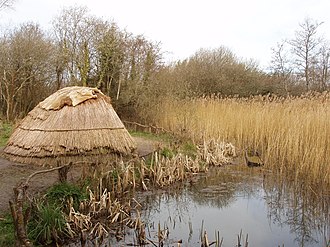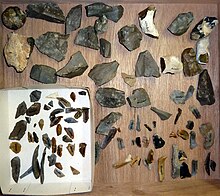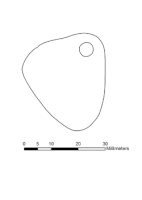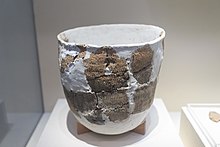
Reconstruction of a "temporary" Mesolithic house in Ireland; waterside sites offered good food resources.
| |
| Alternative names | Epipaleolithic (for the Near East) |
|---|---|
| Geographical range | Europe |
| Period | End of Stone Age |
| Dates | 20,000 to 8,000 BP (Southwest Asia) 15,000–5,000 BP (Europe) |
| Preceded by | Upper Paleolithic |
| Followed by | Neolithic |
In Old World archaeology, Mesolithic (Greek: μέσος, mesos "middle"; λίθος, lithos "stone") is the period between the Upper Paleolithic and the Neolithic. The term Epipaleolithic is often used synonymously, especially for outside northern Europe, and for the corresponding period in the Levant and Caucasus. The Mesolithic has different time spans in different parts of Eurasia. It refers to the final period of hunter-gatherer cultures in Europe and Western Asia, between the end of the Last Glacial Maximum and the Neolithic Revolution. In Europe it spans roughly 15,000 to 5,000 BP; in Southwest Asia (the Epipalaeolithic Near East) roughly 20,000 to 8,000 BP. The term is less used of areas further east, and not at all beyond Eurasia and North Africa.
The type of culture associated with the Mesolithic varies between areas, but it is associated with a decline in the group hunting of large animals in favour of a broader hunter-gatherer way of life, and the development of more sophisticated and typically smaller lithic tools and weapons than the heavy chipped equivalents typical of the Paleolithic. Depending on the region, some use of pottery and textiles may be found in sites allocated to the Mesolithic, but generally indications of agriculture are taken as marking transition into the Neolithic. The more permanent settlements tend to be close to the sea or inland waters offering a good supply of food. Mesolithic societies are not seen as very complex, and burials are fairly simple; grandiose burial mounds are another mark of the Neolithic.
Terminology
The Mesolithic is the final period of the Pleistocene characterized by a progressive rise of temperatures, between the end of the Last Glacial Maximum (LGM) and the Neolithic Revolution at the start of the Holocene. Evolution of temperature in the Post-Glacial period according to Greenland ice cores.
Mesolithic artefacts
The terms "Paleolithic" and "Neolithic" were introduced by John Lubbock in his work Pre-historic Times
in 1865. The additional "Mesolithic" category was added as an
intermediate category by Hodder Westropp in 1866. Westropp's suggestion
was immediately controversial. A British school led by John Evans denied any need for an intermediate: the ages blended together like the colors of a rainbow, he said. A European school led by Louis Laurent Gabriel de Mortillet asserted that there was a gap between the earlier and later.
Edouard Piette claimed to have filled the gap with his naming of the Azilian Culture. Knut Stjerna
offered an alternative in the "Epipaleolithic", suggesting a final
phase of the Paleolithic rather than an intermediate age in its own
right inserted between the Paleolithic and Neolithic.
By the time of Vere Gordon Childe's work, The Dawn of Europe
(1947), which affirms the Mesolithic, sufficient data had been
collected to determine that a transitional period between the
Paleolithic and the Neolithic was indeed a useful concept.
However, the terms "Mesolithic" and "Epipalaeolitic" remain in
competition, with varying conventions of usage. In the archaeology of
Northern Europe, for example for archaeological sites in Great Britain,
Germany, Scandinavia, Ukraine, and Russia, the term "Mesolithic" is
almost always used. In the archaeology of other areas, the term
"Epipaleolithic" may be preferred by most authors, or there may be
divergences between authors over which term to use or what meaning to
assign to each. In the New World, neither term is used (except
provisionally in the Arctic).
"Epipaleolithic" is sometimes also used alongside "Mesolithic"
for the final end of the Upper Paleolithic immediately followed by the
Mesolithic. As "Mesolithic" suggests an intermediate period, followed by the Neolithic, some authors prefer the term "Epipaleolithic" for hunter-gatherer
cultures who are not succeeded by agricultural traditions, reserving
"Mesolithic" for cultures who are clearly succeeded by the Neolithic
Revolution, such as the Natufian culture.
Other authors use "Mesolithic" as a generic term for post-LGM
hunter-gatherer cultures, whether they are transitional towards
agriculture or not. In addition, terminology appears to differ between
archaeological sub-disciplines, with "Mesolithic" being widely used in
European archaeology, while "Epipalaeolithic" is more common in Near
Eastern archaeology.
Europe
The Shigir Idol
Two
skeletons of women aged between 25 and 35 years, dated between 6740 and
5680 BP, both of whom died a violent death. Found at Téviec, France in 1938.
The Balkan Mesolithic begins around 15,000 years ago. In Western Europe, the Early Mesolithic, or Azilian, begins about 14,000 years ago, in the Franco-Cantabrian region of northern Spain and southern France. In other parts of Europe, the Mesolithic begins by 11,500 years ago (the beginning Holocene), and it ends with the introduction
of farming, depending on the region between c. 8,500 and 5,500 years
ago. Regions that experienced greater environmental effects as the last glacial period ended have a much more apparent Mesolithic era, lasting millennia.
In northern Europe, for example, societies were able to live well on
rich food supplies from the marshlands created by the warmer climate.
Such conditions produced distinctive human behaviors that are preserved
in the material record, such as the Maglemosian and Azilian cultures. Such conditions also delayed the coming of the Neolithic until some 5,500 BP in northern Europe.
The type of stone toolkit remains one of the most diagnostic
features: the Mesolithic used a microlithic technology – composite
devices manufactured with Mode V chipped stone tools (microliths),
while the Paleolithic had utilized Modes I–IV. In some areas, however,
such as Ireland, parts of Portugal, the Isle of Man and the Tyrrhenian
Islands, a macrolithic technology was used in the Mesolithic.
In the Neolithic, the microlithic technology was replaced by a
macrolithic technology, with an increased use of polished stone tools
such as stone axes.
There is some evidence for the beginning of construction at sites with a ritual or astronomical significance, including Stonehenge, with a short row of large post holes aligned east-west, and a possible "lunar calendar" at Warren Field in Scotland, with pits of post holes of varying sizes, thought to reflect the lunar phases. Both are dated to before c. 9,000 BP (the 8th millennium BC).
As the "Neolithic package" (including farming, herding, polished stone axes, timber longhouses
and pottery) spread into Europe, the Mesolithic way of life was
marginalized and eventually disappeared. Mesolithic adaptations such as
sedentism, population size and use of plant foods are cited as evidence
of the transition to agriculture. In one sample from the Blätterhöhle in Hagen,
it seems that the descendants of Mesolithic people maintained a
foraging lifestyle for more than 2000 years after the arrival of farming
societies in the area; such societies may be called "Subneolithic". In north-Eastern Europe, the hunting and fishing lifestyle continued into the Medieval period in regions less suited to agriculture, and in Scandinavia no Mesolithic period may be accepted, with the locally preferred "Older Stone Age" moving into the "Younger Stone Age".
Art
Compared to the
preceding Upper Paleolithic and the following Neolithic, there is
rather less surviving art from the Mesolithic. The Rock art of the Iberian Mediterranean Basin,
which probably spreads across from the Upper Paleolithic, is a
widespread phenomenon, much less well known than the cave-paintings of
the Upper Paleolithic, with which it makes an interesting contrast. The
sites are now mostly cliff faces in the open air, and the subjects are
now mostly human rather than animal, with large groups of small figures;
there are 45 figures at Roca dels Moros.
Clothing is shown, and scenes of dancing, fighting, hunting and
food-gathering. The figures are much smaller than the animals of
Paleolithic art, and depicted much more schematically, though often in
energetic poses. A few small engraved pendants with suspension holes and simple engraved designs are known, some from northern Europe in amber, and one from Star Carr in Britain in shale. The Elk's Head of Huittinen is a rare Mesolithic animal carving in soapstone from Finland.
The rock art in the Urals appears to show similar changes after the Paleolithic, and the wooden Shigir Idol is a rare survival of what may well have been a very common material for sculpture. It is a plank of larch
carved with geometric motifs, but topped with a human head. Now in
fragments, it would apparently have been over 5 metres tall when made. The Ain Sakhri Lovers from modern Israel, are a Natufian carving in calcite.
- The Ain Sakhri lovers; c. 9000 BCE (late Epipalaeolithic Near East); calcite; height: 10.2 cm, width: 6.3 cm; from Ain Sakhri (near Bethleem, Israel); British Museum (London)
- Animated image showing the sequence of engravings on a pendant excavated from the Mesolithic archaeological site of Star Carr in 2015
- Roca dels Moros, Spain, The Dance of Cogul, tracing by Henri Breuil
Ceramic Mesolithic
In
North-Eastern Europe, Siberia, and certain southern European and North
African sites, a "ceramic Mesolithic" can be distinguished between c.
9,000 to 5,850 BP. Russian archaeologists prefer to describe such
pottery-making cultures as Neolithic, even though farming is absent.
This pottery-making Mesolithic culture can be found peripheral to the
sedentary Neolithic cultures. It created a distinctive type of pottery,
with point or knob base and flared rims, manufactured by methods not
used by the Neolithic farmers. Though each area of Mesolithic ceramic
developed an individual style, common features suggest a single point of
origin.
The earliest manifestation of this type of pottery may be in the region
around Lake Baikal in Siberia. It appears in the Elshan or Yelshanka or
Samara culture on the Volga in Russia 9 ka, and from there spread via the Dnieper-Donets culture to the Narva culture of the Eastern Baltic. Spreading westward along the coastline it is found in the Ertebølle culture of Denmark and Ellerbek of Northern Germany, and the related Swifterbant culture of the Low Countries.
Pottery with re-construction repairs found in Xianrendong cave, dating to 20,000–10,000 years ago.
A 2012 publication in the Science
journal, announced that the earliest pottery yet known anywhere in the
world was found in Xianrendong cave in China, dating by radiocarbon to
between 20,000 and 19,000 years before present, at the end of the Last Glacial Period. The carbon 14 datation was established by carefully dating surrounding sediments. Many of the pottery fragments had scorch marks, suggesting that the pottery was used for cooking. These early pottery containers were made well before the invention of agriculture (dated to 10,000 to 8,000 BC), by mobile foragers who hunted and gathered their food during the Late Glacial Maximum.
Cultures
| Geographical range | Periodization | Culture | Temporal range | Notable sites |
|---|---|---|---|---|
| Southeastern Europe (Greece, Aegean) | Balkan Mesolithic |
|
15,000–7,000 BP | Franchthi, Theopetra |
| Southeastern Europe (Romania/Serbia) | Balkan Mesolithic | Iron Gates culture | 13,000–5,000 BP | Lepenski Vir |
| Western Europe | Early Mesolithic | Azilian | 14,000–10,000 BP | |
| Northern Europe (Norway) |
|
Fosna-Hensbacka culture | 12,000–10,500 BP | |
| Northern Europe (Norway) | Early Mesolithic | Komsa culture | 12,000–10,000 BP | |
| Central Asia (Middle Urals) |
|
|
12,000–5,000 BP | Shigir Idol, Vtoraya Beregovaya |
| Northeastern Europe (Baltics and Russia) | Middle Mesolithic | Kunda culture | 10,500–7,000 BP | Lammasmägi, Pulli settlement |
| Northern Europe |
|
Maglemosian culture | 11,000–8,000 BP | |
| Western and Central Europe |
|
Sauveterrian culture | 10,500–8,500 BP | |
| Western Europe (Great Britain) | British Mesolithic |
|
11,000–5,500 BP | Star Carr, Howick house, Gough's Cave, Cramond, Aveline's Hole |
| Western Europe (Ireland) | Irish Mesolithic |
|
11,000–5,500 BP | Mount Sandel |
| Western Europe (Belgium and France) |
|
Tardenoisian culture | 10,000–5,000 BP | |
| Eastern Europe (Belarus, Lithuania and Poland) | Late Mesolithic | Neman culture | 9,000–5,000 BP | |
| Northern Europe (Scandinavia) |
|
Nøstvet and Lihult cultures | 8,200–5,200 BP | |
| Northern Europe (Scandinavia) |
|
Kongemose culture | 8,000–7,200 BP | |
| Northern Europe (Scandinavia) | Late Mesolithic | Ertebølle | 7,300–5,900 BP | |
| Western Europe (Netherlands) | Late Mesolithic | Swifterbant | 7,300–5,400 BP |
"Mesolithic" outside of Western Eurasia
Mesolithic stone mortar and pestle, Kebaran culture, Epipaleolithic Near East. 22,000–18,000 BP
While Paleolithic and Neolithic have been found useful terms and concepts in the archaeology of China,
and can be mostly regarded as happily naturalized, Mesolithic was
introduced later, mostly after 1945, and does not appear to be a
necessary or useful term in the context of China. Chinese sites that
have been regarded as Mesolithic are better considered as "Early
Neolithic".
In the archaeology of India, the Mesolithic, dated roughly between 12,000 and 8,000 BP, remains a concept in use.
In the archaeology of the Americas, an Archaic or Meso-Indian period, following the Lithic stage, somewhat equates to the Mesolithic.
| Geographical range | Periodization | Culture | Temporal range | Notable sites |
|---|---|---|---|---|
| North Africa (Morocco) | Late Upper Paleolithic to Early Mesolithic | Iberomaurusian culture | 24,000–10,000 BP | |
| North Africa |
|
Capsian culture | 12,000–8,000 BP |
|
| East Africa |
|
Kenya Meseolithic | 8,200–7,400 BP | Gamble's cave |
| Central Asia (Middle Urals) |
|
|
12,000–5,000 BP | Shigir Idol, Vtoraya Beregovaya |
| East Asia (Japan) | Jōmon cultures |
|
16,000–1,350 BP | |
| East Asia (Korea) | Jeulmun pottery period |
|
10,000–3,500 BP | |
| South Asia (India) | South Asian Stone Age |
|
12,000–4,000 BP | Bhimbetka rock shelters |









